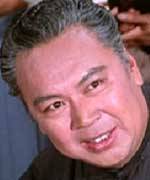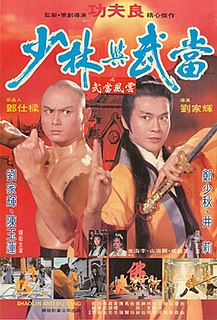Related Research Articles

Sammo Hung, also known as Hung Kam-bo (洪金寶), is a Hong Kong actor, martial artist, film producer and director, known for his work in martial arts films, Hong Kong action cinema, and as a fight choreographer for other actors such as Jackie Chan.

Shaolin Kung Fu, also called Shaolin Wushu, or Shaolin quan, is one of the oldest, largest, and most famous styles of wushu, or kung fu of Chan Buddhism. It combines Ch'an philosophy and martial arts and originated and was developed in the Shaolin temple in Henan province, Greater China during its 1500-year history. Popular sayings in Chinese folklore related to this practice include "All martial arts under heaven originated from Shaolin" and "Shaolin kung fu is the best under heaven," indicating the influence of Shaolin kung fu among martial arts. The name Shaolin is also used as a brand for the so-called external styles of kung fu. Many styles in southern and northern China use the name Shaolin.

Northern Praying Mantis is a style of Chinese martial arts, sometimes called Shandong Praying Mantis after its province of origin. It was created by Wang Lang (王朗) and was named after the praying mantis, an insect, the aggressiveness of which inspired the style. One Mantis legend places the creation of the style in the Song Dynasty when Wang Lang was supposedly one of 18 masters gathered by the Abbot Fu Ju (福居), a legendary persona of the historical Abbot Fu Yu (福裕) (1203–1275), to improve Shaolin martial arts. However, most legends place Wang Lang in the late Ming Dynasty.

Chinese martial arts, often called by the umbrella terms kung fu, kuoshu or wushu, are multiple fighting styles that have developed over the centuries in Greater China. These fighting styles are often classified according to common traits, identified as "families" of martial arts. Examples of such traits include Shaolinquan (少林拳) physical exercises involving All Other Animals (五形) mimicry or training methods inspired by Old Chinese philosophies, religions and legends. Styles that focus on qi manipulation are called internal, while others that concentrate on improving muscle and cardiovascular fitness are called external. Geographical association, as in northern and southern, is another popular classification method.

The 36th Chamber of Shaolin, also known as The Master Killer, Shaolin Master Killer and Shao Lin San Shi Liu Fang, is a 1978 Hong Kong kung fu film directed by Lau Kar-leung and produced by Shaw Brothers, starring Gordon Liu. The film follows a highly fictionalized version of San Te, a legendary Shaolin martial arts disciple who trained under the general Chi Shan.
Mark Joseph Salzman is an American writer. Salzman is best known for his 1986 memoir Iron & Silk, which describes his experiences living in China as an English teacher in the early 1980s.

White Crane Style is a Southern Chinese martial art that originated in Yongchun County, Fujian (福建) province. According to oral tradition, the style was developed by Fang Qiniang, a female martial artist. It is associated with traditional fighting techniques, including long range, but is most similar to close-quarter or hand-to-hand combat. It is most recognizable by the way the fighter imitates a bird's pecking or flapping of wings. While some white crane styles make use of traditional weapons, others have discontinued the use of weaponry.

Lo Wei was a Hong Kong film director and film actor best known for launching the martial arts film careers of both Bruce Lee, in The Big Boss and Fist of Fury, and Jackie Chan, in New Fist of Fury.

Shaolin and Wu Tang is a 1983 Hong Kong martial arts film directed by and starring Gordon Liu. The film is about the rivalry between the Shaolin and Wu-Tang martial arts schools. It is also called Shaolin vs. Wu-Tang in the Master Killer Collection.
Pan Qingfu, also known as Grandmaster Pan, was a Chinese martial artist.

Zhou Tong was the archery teacher and second military arts tutor of famous Song dynasty general Yue Fei. Originally a local hero from Henan, he was hired to continue Yue Fei's military training in archery after the boy had rapidly mastered spearplay under his first teacher. In addition to the future general, Zhou accepted other children as archery pupils. During his tutelage, Zhou taught the children all of his skills and even rewarded Yue with his two favorite bows because he was his best pupil. After Zhou's death, Yue would regularly visit his tomb twice a month and perform unorthodox sacrifices that far surpassed that done for even beloved tutors. Yue later taught what he had learned from Zhou to his soldiers and they were successful in battle.
Kung fu film is a subgenre of martial arts films and Hong Kong action cinema set in the contemporary period and featuring realistic martial arts. It lacks the fantasy elements seen in wuxia, a related martial arts genre that uses historical settings based on ancient China. Swordplay is also less common in kung-fu films than in wuxia and fighting is done through unarmed combat.

The Prodigal Son is a 1981 Hong Kong martial arts comedy film starring Yuen Biao and directed by Sammo Hung, who also co-starred and wrote with Barry Wong. The film was released on 22 December 1981 and grossed HK$9,150,729. The Prodigal Son was nominated for two Hong Kong Film Awards and won the award for Best Action Choreography.

Various martial arts have been attributed to or associated with Zhou Tong, the archery teacher of Song Dynasty general, Yue Fei. This is because assorted wuxia novels and folk legends portray him as being either a Shaolin monk or a lay disciple of Shaolin. Some of these skills range from mastery of the bow, double swords and Chinese spear to that of Wudang hard qigong, Chuojiao boxing and even magical X-ray eyes. However, the oldest historical record that mentions his name only says he taught archery to Yue Fei. Nothing is ever said about him knowing or teaching a specific style of Chinese martial arts.

Iron and Silk is a 1986 autobiographical novel written by Mark Salzman. It describes his experiences in China as an English teacher and as a student of Kung Fu. The book was later made into a film of the same name.
He Saifei is a Chinese actress of film and television, as well as a celebrated Yue opera performer of dan (female) roles. Internationally, she is best known for playing supporting roles in period films like Raise the Red Lantern (1991) and Temptress Moon (1996).

Dick Wei is a Taiwanese actor, director and writer who specializes in martial arts and action films.
Phillip Ko-Fei was a Hong Kong filmmaker.

Zhejiang Xiaobaihua Yue Opera Troupe is a professional all-women Yue opera troupe in Hangzhou, Zhejiang, China. Along with Zhejiang Yue Opera Troupe and Shanghai Yueju Troupe, it is one of China's most famous Yue opera troupes. It has toured the U.S., France, Holand, Belgium, Japan, South Korea, Singapore, Thailand, Hong Kong, Macao, Taiwan and other places.
Birthday Celebration by Five Daughters (五女拜壽) is a Chinese Yue opera play written by Gu Xidong (顾锡东) in 1982, set in the Ming dynasty before and after the fall of Yan Song. There is some similarity between the story and that of King Lear, although Gu Xidong never acknowledged any Shakespearean influence. The story emphasizes the importance of traditional Confucian values such as filial piety, which like traditional theatre had been attacked and suppressed during the Cultural Revolution (1966–1976).
References
- ↑ Kristof, Nicholas D. (January 22, 1989). "FILM; An Old Eli Performs As Kung Fu Star in China". The New York Times . Retrieved 2010-12-17.
- ↑ Brown, Joe (March 8, 1991). "Iron & Silk". Washington Post . Retrieved 2010-12-16.
- ↑ Thomas, Kevin (March 8, 1991). "MOVIE REVIEW : 'Iron & Silk': Innocent Abroad". The Los Angeles Times . Retrieved 2010-12-16.
- ↑ Kehr, Dave (February 22, 1991). "Ambiguous 'Iron & Silk' Is Cut From Different Cloth". Chicago Tribune . Retrieved 2011-03-29.
- ↑ Briggs, Joe Bob (October 9, 1992). "'Iron & Silk': Ok, It's Great Kung Fu But The Star Is A Wimp". Orlando Sentinel . Retrieved 2022-02-12.